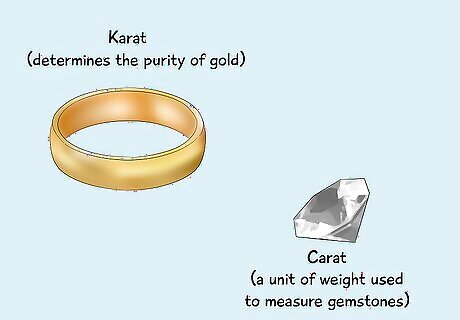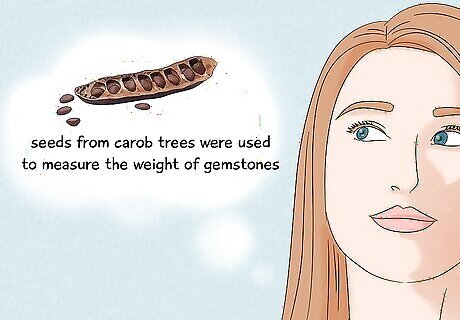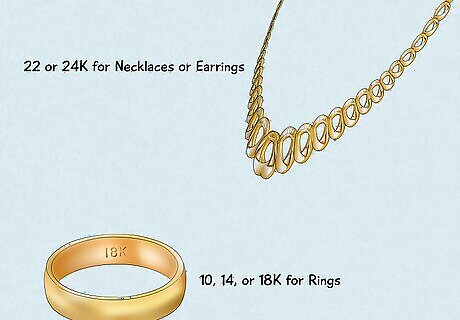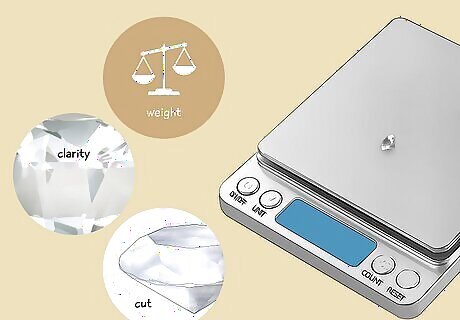
views
The Difference Between “Karat” and “Carat”

A karat is a measurement of the purity of gold. Gold is a highly malleable metal, so it’s not very durable on its own. Because of this, gold jewelry is often made from a mixture of gold and other metals (called alloys) to increase its toughness. An individual karat represents 1/24 of the whole unit of gold. The fineness of the gold is then determined by how many of these 24 parts are pure gold, and how many are other metal alloys. In other words, if the gold used to make a piece of jewelry is 18 parts pure gold and 6 parts other metal alloys, it is 18-karat gold. A piece of jewelry made exclusively with pure gold and no metals alloys would be 24-karat gold.

A carat is a unit of weight used to measure gemstones. A single carat equals 200 milligrams, or .2 grams. This means that a 1-carat diamond weighs 200 milligrams, a 2-carat diamond weighs 400 milligrams, a 3-carat diamond weighs 600 milligrams, and so on. You’ve probably heard the term “carat” in relation to diamonds, but they’re also used to measure other precious stones like emeralds, sapphires, and rubies.

Gold karats are not the same thing as diamond carats. Outside of the U.S., the word “karat” can also be spelled with a “C.” This causes some people to confuse gold karats with diamond carats. These two things are separate and distinct from each other, even though they sometimes share a spelling.
Origins of the Words “Karat” & “Carat”

The words “karat” and “carat” come from the Greek word keration. Keration means carob seed, and it also refers to a small unit of weight. Throughout the ancient world, seeds from carob trees were used to measure the weight of gemstones and other small items. These seeds were called “carats,” so a gem that weighed one seed was said to weigh a carat. The word “karat” later came to be used as a measurement of the fineness of gold around the late 15th century.
How to Tell If Gold Is Real

Take your gold to a reputable jeweler to determine its authenticity. This is a surefire way to find out if your gold jewelry is real or not. If you want to try at home, inspect the gold to see if it’s stamped with a karat number. Real gold should be stamped somewhere with its karat measurement, usually 10K, 14K, or 18K. You can also drop your gold into a glass of water to check its authenticity. If it floats, it’s definitely fake, but if it sinks to the bottom, there’s a better chance it’s real. Neither of these home tests are totally foolproof, so it’s best to take your gold to a jeweler if you want to be absolutely sure of its authenticity.
How to Choose the Best Karat for Gold Jewelry

The best gold karat depends on the type of jewelry you’re looking for. For items like rings that can easily get scuffed or damaged, lower karat gold (10, 14, or 18K) is usually better. This is because it's more tough and durable. If you want to purchase 22-karat or 24-karat gold, go for items that you’d wear on more protected areas of your body, like necklaces or earrings.
How to Choose a Carat Weight for Diamond Jewelry

Carat weight is just one factor to consider when choosing a diamond. Though a higher carat weight may indicate a more expensive diamond, clarity, color, and cut are also taken into consideration when determining a diamond’s value. A single carat diamond can also look dramatically different depending on its shape (princess, pear, oval, marquise, etc). It’s important to weigh all of these factors when picking a diamond. You may prefer a diamond that has a smaller carat weight, but better clarity or a rarer color. On the other hand, the diamond’s size may be the most important thing to you, so you’d be willing to sacrifice a bit on clarity, cut, or color. Ultimately, the right choice for you will depend on a unique combination of factors and your personal budget.




















Comments
0 comment